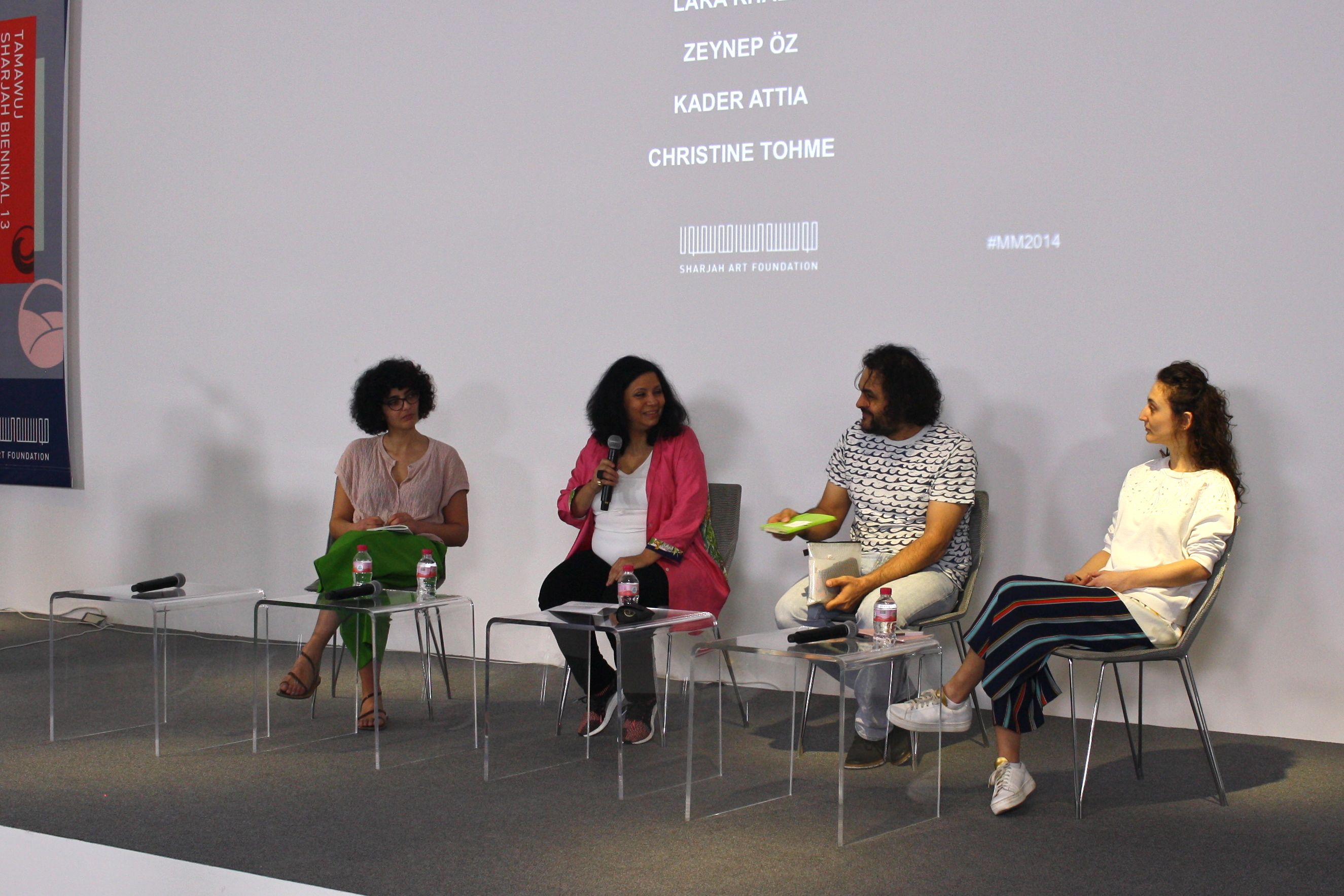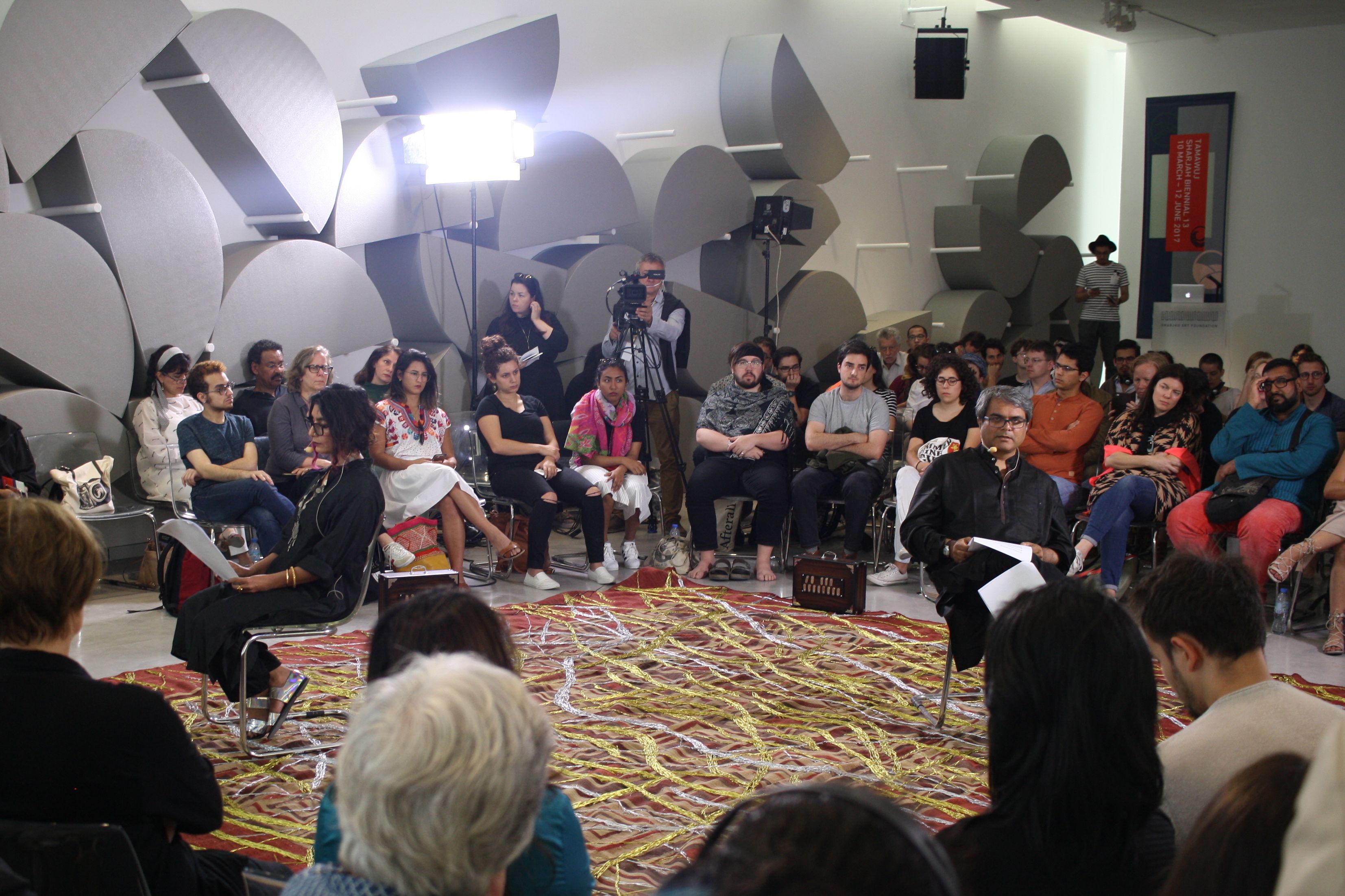Sharjah Biennial 13, Tamawuj: Day 2
By HG Masters

Left to right: Sharjah Biennial 13 "interlocutors": Lara Khaldi, SB13 curator Christine Tohm
The experience of Sharjah Biennial 13 (SB13) is, so far, akin to stepping into an ongoing conversation. Even if you have some idea about the topics, there’s a lot that’s been discussed already and you are just catching up. That was the case on the second day of SB13’s opening week, when curator Christine Tohmé and three interlocutors—Lara Khaldi, Kader Attia and Zeynep Öz—took the stage and launched into a meandering discussion about their working process and the development of the biennial’s themes. I noticed that even after two mornings of presentations, no one has mentioned the biennial’s title, “Tamawuj,” or its various meanings and its relationship to the four keywords (water, crops, earth, culinary) and to the biennial itself. There was also considerable confusion about this thing called the "Chip Ship" that the interlocutors kept mentioning, before it was explained an hour later in the Q&A session that this is in fact a closed-network platform where biennial-affiliated researchers were uploading materials and documents for other participants to read and share.
Other things that we learned from this conversation was that each of the off-site programs will have a different structure: Kader Attia’s program called “Vive L’Indépendence de l’Eau,” held in Dakar in January, was a two-day symposium (I wrote a summary of that event, here); Zeynep Öz’s project about “crops” in Istanbul in May will be a series of newly commissioned artworks; and in early August, Lara Khaldi will use her platform in Ramallah (“earth”) as a publisher for 40 artists' books. Finally, Ashkal Alwan’s event in October will be a discursive platform similar to the Home Works forum, with two exhibitions, one curated by Reem Fadda and the other by Hicham Khalidi, around the keyword “culinary.”
Along with releasing these nuggets of (previously undisclosed) information about SB13, Tohmé said she didn’t want to exhibit “packaged works” and that her goal was, “to make Sharjah a factory” whose productions had started in Dakar and will continue in Istanbul, Ramallah and Beirut. Ultimately, she said, she wants to challenge herself and her collaborators, and to question these actions. She added: “Maybe there is something wrong in the structure of what we are doing. I’m not sure what the answer is.” Clearly, the regional crises—referenced obliquely on the first morning—had been weighing on her thoughts. "Many of my colleagues say this is the worst time we have ever confronted in the region, and I say, no, this time has happened before,” she argued, later making repeated references to the struggles of the 1990s, particularly around the mobility of people in the region. Tohmé even went so far as to wonder aloud whether we, collectively, were all responsible or at least implicated (she made clear she was talking primarily about herself here) in the ongoing conflicts. She said she was struggling with whether and how a small-scale organization like Ashkal Alwan could continue to function.
Woven in between Tohmé's reflections was Kader Attia's responses to these comments. Attia, who was wearing a T-shirt with the pattern of waves on it, spoke about his symposium in Dakar where he said he was trying to “re-enact a field of emotion.” He recalled how in the 1960s and ’70s, intellectual activists like Jean Genet, Michel Foucault and Angela Davis had been “in the street,” but that in the 1980s and ’90s, the activity faded as many of that generation perished in the AIDS crisis or became elderly. He noted that what is scary today is that the “field of emotion has been re-appropriated by populism, starting with [former Italian prime minister] Berlusconi.” As cultural producers, he continued to say, we need to reconnect with this field. As an example, Attia said he had recently become interested in folk art and music, specifically fishermen’s songs in Senegal—which also formed a point of connection with Sharjah, another port city, and was an “escape from the first degree of a theme.” Later, Zeynep Öz chimed in about ideas of dormancy and the potency of a seed and its decision about when to re-awaken—which perhaps reflects a certain mood in Istanbul where visibility can be dangerous, and which is why her project will be titled “Bahar,” meaning “spring” in Turkish.
Many threads later, after discussions on “strategies for survival” and Lara Khaldi extolling the humor and virtues of a novel called The Pessoptimist by Emile Habibi, the conversation ended on an provocative question from Shahira Issa, who remarked that she had recently learned that there are still members of the Gulf Labor group who cannot travel to the UAE. Issa said this had changed her own perspective on being in Sharjah, and that she thought it would be unfortunate if we all had arrived in city, unaware of the situation. Tohmé thanked Issa for the question, and noted that, for herself, the issue was not only about Gulf Labor but about labor issues everywhere in the world. “I have been working for the past 25 years to get people to Beirut, and so many people have not been allowed to enter: Palestinians, Syrians,” she said. She also noted that for this biennial, Sharjah Art Foundation had struggled a fair amount to secure visas for many of the participating artists, and she was against this “culture of securitization” both in her home country and elsewhere. Attia (who is a signatory of the original Gulf Labor petition) also thanked Issa for the question and said he thought it hadn’t come up in their curatorial discussions because they had assumed it would come up naturally and that they had “stayed focused on the elements [of the biennial] and as much as possible on what is gathering beyond the borders of the art world, people and all the ‘emotion.’”

RAQS MEDIA COLLECTIVE, The Necessity of Infinity, 2017, performance and carpet.
Two performances followed the morning conversation. First up was Raqs Media Collective’s performance The Necessity of Infinity (2017), in which two of the three members (Monica Narula and Shuddhabrata Sengupta) sat on chairs on a red carpet covered in gold and silver threads and engaged in an evolving and hypnotic philosophical debate about the nature of the universe, with lines such as: “There’s no reason that our tour of the universe needs to be a one-stop journey. And there’s no reason for creation not to be beset by doubt, and fits and starts, and false-starts and by interruptions and by changes of direction.” And lunch itself was an event, orchestrated by Cooking Sections, Daniel Fernández Pascual & Alon Schwabe, a London-based duo who for this multi-coursed meal dedicated to “the movement of aridity” had utilized a variety of local ingredients to illustrate that farming and eating practices in a dry place like the Gulf can be sustainable. We were seated on stools clustered around a labyrinthine metal table that was shaped on “patterns of desertification.” Our highly self-conscious and deliciously activistic meal started with a “Dryland Salinity Drink” (tamarind, agave and jujube) and a “Dune Stabilization Salad” comprised of sea asparagus and capers, followed by a dish of “Water Accumulators,” namely prickly pear and nopal. I made it as far as the baked cassava pieces in the dish dubbed “Insurance Crop Sticks” before I needed to hop onto a bus to go to the Planetarium and the Flying Saucer and see some of the biennial itself. I’ll get into those works as we see more in the coming days, and in the next blog posts.
HG Masters is editor-at-large of ArtAsiaPacific.
To read more of ArtAsiaPacific’s articles, visit our Digital Library.







